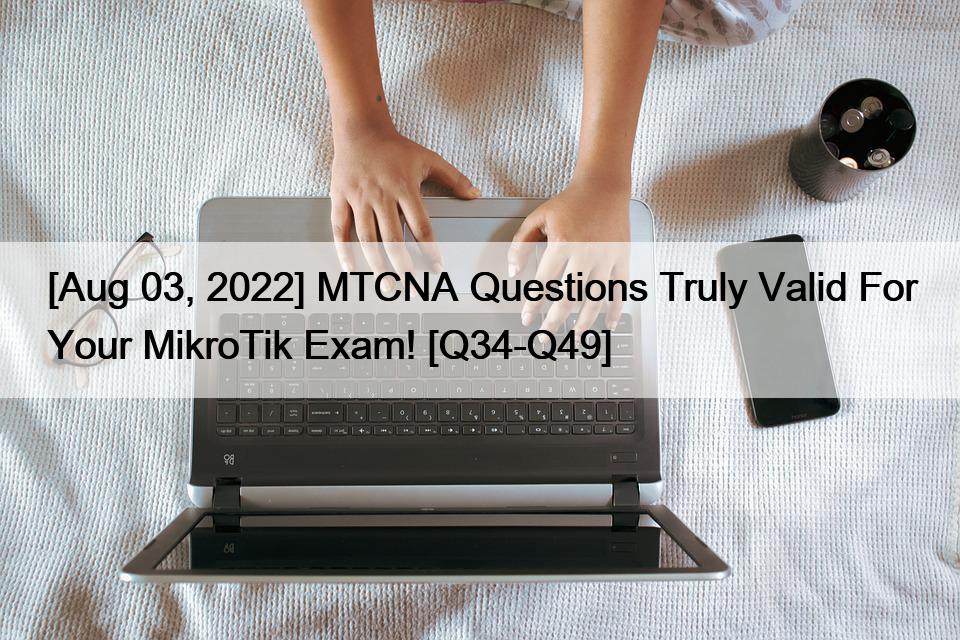
[Aug 03, 2022] MTCNA Questions Truly Valid For Your MikroTik Exam!
MTCNA Actual Questions – Instant Download Tests Free Updated Today!
Difficulty in Writing MikroTik Certified Network Associate (MTCNA) Exam
For those candidates who do not exercise during prep work, the MikroTik Certified Network Associate (MTCNA) exam is very difficult and candidates need a practice environment as well. Functional direct exposure is then greatly needed to grasp the components of the test. So, if any person can not afford the laboratory and also do not have time to exercise, it would be better if he is affiliated with some kind of a company where he has opportunities to practice. As the popularity of the MikroTik Certified Network Associate (MTCNA) certified increases, MikroTik upgrades its tech system and brings brand-new innovations to the market. The complexity of passing the MikroTik Certified Network Associate (MTCNA) exam is also increased by this. To survive in the IT sector, candidates must pass the MikroTik Certified Network Associate (MTCNA) exam. Refer to the links down below for MTCNA exam dumps and other materials, sample problems, and MTCNA practice exam dumps for your preparation. Practicing the sample questions will guarantee your success in the MikroTik accreditation exam at the first attempt. The material is kept up to date regularly.
DumpsTorrent provide MTCNA exam dumps which have, over the years, proved out to be the best learning materials and have ensured unbelievable passing rates.
How much MikroTik Certified Network Associate (MTCNA) Exam Cost
The price of the MikroTik Certified Network Associate (MTCNA) Exam is around USD 300. For more information related to exam price, please visit the official website MikroTik Website as the cost of exams may be subjected to vary county-wise. Candidates will encounter preparation costs as well like paying for MTCNA exam dumps pdf and MTCNA practice exams.
Topics of MikroTik Certified Network Associate (MTCNA) Exam
The syllabus may get updated anytime so it is always recommended to visit the official website of MikroTik or check the updated MTCNA exam dumps to access the latest course contents. The following contents are included in the MikroTik Certified Network Associate (MTCNA) exam:
1. Introduction
This module constitutes of the following subtopics:
- Difference between a backup and an export (.rsc) file
- Upgrading RouterOS
- What is RouterOS
- Default configuration
- WebFig and Quick Set
- SSH and Telnet
- WinBox and MAC-WinBox
- About MikroTik
- Package types
- Initial configuration (Internet access)
- LAN IP address and default gateway
- Ways of upgrading
- RouterOS license levels
- Manage RouterOS services
- RouterOS CLI principles
- Resetting a RouterOS device
- Command history and its benefits
- RouterBOOT firmware upgrade
- Reinstalling a RouterOS device (Netinstall)
- Router identity
- Null Modem cable
- Managing configuration backups
- Saving and restoring the backup
- RouterOS command-line interface (CLI)
- New terminal in WinBox/WebFig
- Editing an export file
- What is RouterBOARD
- Manage RouterOS logins
- First time accessing the router
- Basic Firewall – NAT masquerade
2. DHCP
This module constitutes of the following subtopics:
- ARP modes
- Leases management
- DHCP client
- Address Resolution Protocol (ARP)
- DHCP server setup
3. Bridging
This module constitutes of the following subtopics:
- Bridge concepts and settings
- Adding ports to bridges
- Station bridge
4. Routing
This module constitutes of the following subtopics:
- Implementing static routing in a simple network
- Managing dynamic routes
- Static routing
- Routing overview
- Routing concepts
- Setting default route
5. Wireless
This module constitutes of the following subtopics:
- Snooper
- Wireless Security and Encryption
- WPA-PSK, WPA2-PSK
- Default Authenticate
- WPS accept, WPS client
- Default Forward
- Connect List
- Station configuration
- Setup a simple wireless link
- 802.11a/b/g/n/ac Concepts
- Access List
- Registration table
- Monitoring Tools
6. Firewall
This module constitutes of the following subtopics:
- DST-nat and redirect actions
- Protecting your router (input)
- Connection tracking and states
- FastTrack
- Masquerade and src-nat action
- Protection your customers (forward)
- Filter actions
- Source NAT
- Firewall Filter in action
- Destination NAT
- Firewall principles
7. QoS
This module constitutes of the following subtopics:
- Pcq-rate configuration
- Max-limit and limit-at
- Target
- Bursting
- One Simple queue for the whole network (PCQ)
8. Tunnels
This module constitutes of the following subtopics:
- Creating pool
- PPPoE service-name
- PPP status
- IP pool
- PPPoE client
- PPP profile
- PPTP client and a PPTP server (Quick Set)
- Secure local network
- Secure remote networks communication
- Point-to-point addresses
9. Misc
This module constitutes of the following subtopics:
- Netwatch
- Monitoring
- SNMP
- System logs, enabling debug logs
- Network diagrams
- Torch
- The Dude
- Readable configuration (item comments and names)
Get instant access of 100% real exam questions with verified answers: https://www.dumpstorrent.com/MTCNA-exam-dumps-torrent.html